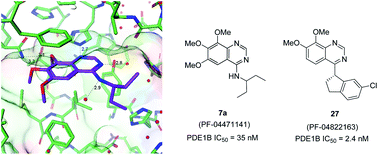Small-molecule phosphodiesterase probes: discovery of potent and selective CNS-penetrable quinazoline inhibitors of PDE1†
Abstract
PDE1 is a family of calcium-activated, dual substrate phosphodiesterases expressed in both the CNS and periphery that play a role in the integration of intracellular calcium and cyclic nucleotide signaling cascades. Exploration of the potential in targeting this family of enzymes to treat neuropsychiatric disorders has been hampered by a lack of potent, selective, and brain penetrable PDE1 inhibitors. To identify such compounds we used high-throughput screening, structure-based design, and targeted synthetic chemistry to discover the 4-aminoquinazoline 7a (PF-04471141) and the 4-indanylquinazoline 27 (PF-04822163) each of which are PDE1 inhibitors that readily cross the blood brain barrier. These quinazoline-based PDE1-selective inhibitors represent valuable new tools to study the biological processes regulated by PDE1 and to begin to determine the potential therapeutic utility of such compounds to treat neuropsychiatric disorders.


 Please wait while we load your content...
Please wait while we load your content...